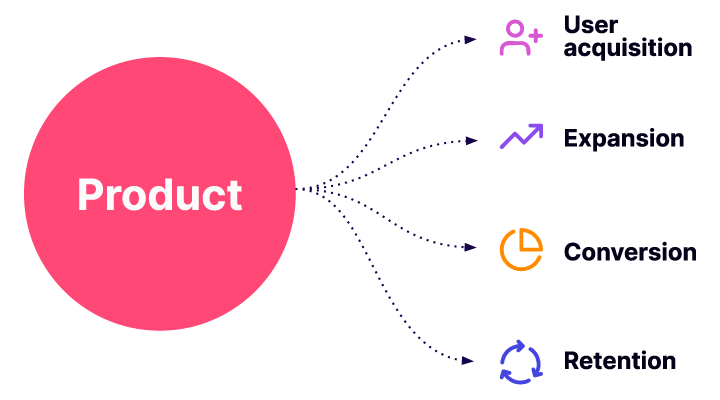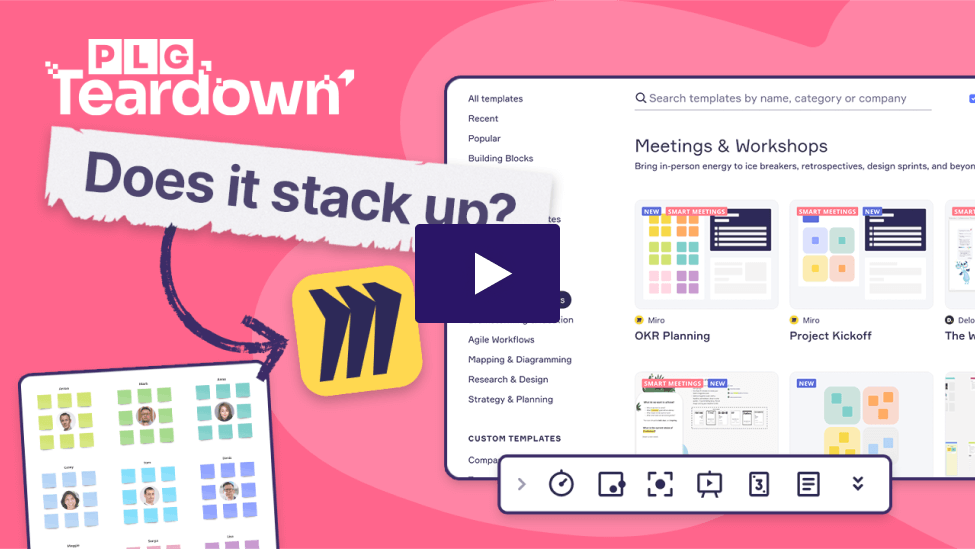Table of Contents
What is product-led growth?
Product-led growth describes a business strategy that places a company’s software at the center of the buying journey—and often at the center of the broader customer experience. A product-led growth strategy counts on the product itself—its features, performance, and virality—to do much of the “selling.”
What makes product-led growth unique?
The main differentiator of product-led growth is that it puts the product front and center of all go-to-market efforts. In product-led organizations, sales and marketing teams reorient to let the product (and the positive social proof it generates) take the lead.
For example, for companies that have a freemium product, the product itself becomes a sales and marketing tool as it attracts new users without spending money on ad campaigns or additional sales hires. Similarly, product-led growth strategies often allow users to experience a product for free, with the intention of showing enough value to encourage them to upgrade to the paid version.

Why is product-led growth important?
As companies grow and the amount of customers and prospects it engages with expands, a 1:1 human-to-human support and sales model becomes less and less sustainable. Product-led growth helps companies continue to scale and grow efficiently by automating some of the key onboarding, support, sales, and marketing functions and letting customers and prospects engage with them in the app itself. In doing so, it frees the humans in a company up to pursue more strategic, meaningful work while having confidence that users of all categories are getting the support and information they need. In other words, product-led growth is not a substitute for human support and ingenuity, but rather a complement to it.
What is the history of product-led growth?
The term “product-led growth” was originally coined in 2016 by Blake Bartlett at OpenView, although the principles that define it had been around before that. What drove the rise of product-led growth were companies experimenting with various ways (“freemium” product models, self-guided tours, etc.) to simultaneously grow and be profitable. In traditional growth models, growth and profitability existed as a dichotomy. Pursuing one came at the expense of the other. Product-led growth overcame this dichotomy, with the companies embracing the tactics and strategies that would become associated with the term seeing unprecedented levels of success in both.
How do self-service trials or freemium drive product-led growth?
Often central to a product-led growth strategy is a self-service trial or freemium option that allows a prospective customer to evaluate the product independently and without charge, bounded by time and/or functionality, and often without engaging a salesperson. This self-service approach aligns to shifting changes in buyer preferences, particularly in the research and evaluation phases of the buying journey. Many buyers want to try before they buy, relying less on a salesperson’s assistance than on their own first-hand experience with the product, in conjunction with customer and social proof that they discover via review sites and social networks.
Many companies use these trial and freemium experiences to measure product usage and engagement, scoring leads and timing and targeting conversion offers and sales outreach accordingly. Citrix, for example, used product analytics to identify a certain trial usage pattern that converted to paying customers at a higher rate than others. The team then created an onboarding flow that steered trial users toward those particular features, and was able to increase their trial conversion rate by 28 percent.
Here’s how OpenView, a leading VC firm focused on expansion-stage software companies, views the importance of product-led growth and the freemium model within it:
How does product-led growth reduce customer acquisition costs?
A product-led growth strategy can have a positive impact on customer acquisition cost (CAC) by reducing the burden on sales teams. Sales and marketing expenses contribute to customer acquisition costs, thus the more downward pressure a company can place on these expenses, the better their efficiency metrics, such as CAC, will appear.
What is a product-led growth strategy?
A product-led growth strategy is one that puts the product at the center of a company’s business growth model. What the strategy looks like in practice will vary by company. It may involve setting targets for key growth metrics—a percentage of new revenue, number or percent of leads of new opportunities, amount of feature or usage growth in existing accounts, etc.—arrived at through product-led tactics such as freemium versions, self-guided demos, and in-app notifications highlighting new feature and product offerings. The more the product itself drives sales, marketing, and support, the more a company is leaning into a product-led strategy.
How do I tie product-led growth into my company’s product-led strategy?
Product-led growth is a subset of a broader product-led strategy, which expands beyond the try/buy phase of a self-service buying journey to include other touch points, pre- and post sales, where the product takes center stage. For example, a product-led strategy may also mean bringing aspects of sales, marketing, service, support, and education inside the product for convenience, reduced friction, and greater contextual relevance to end users. Here, business functions and customer interactions that were previously executed through other channels converge inside the product, all toward the goal of making the product more useful, more engaging and, ultimately, more valuable for customers and end users.
What are some examples of product-led growth?
Different companies embrace product-led growth in different ways. Citrix, for example, created personalized onboarding messaging for the free trial version of its ShareFile product based on the reasons users created an account. Using in-app messaging to speak to users’ specific needs, they saw a 60% increase in free trial conversions. Covetrus, meanwhile, leveraged product analytics to better understand user behaviors, created in-app guidance and onboarding based on those insights, and solicited feedback in-app so that customer priorities became their own.
How can I learn more about product-led growth?
Pendo published a comprehensive e-book on how to create a product-led organization, which is available for download here. It has also created a Product-led Hub full of insightful content on leveraging a company’s product to drive growth and a stronger business.




